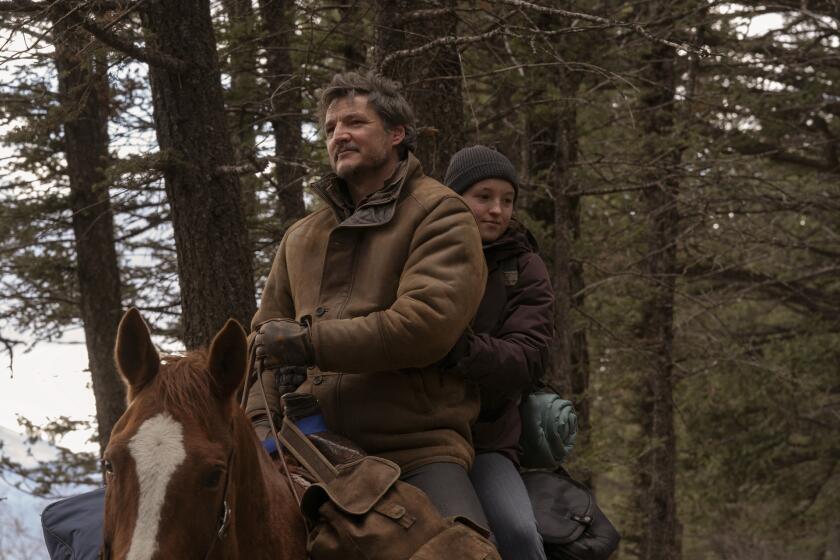Review: St. Lawrence String Quartet’s rare marathon of early Haydn is in-your-face exhilarating
- Share via
Is the Bay Area really the center of classical music disruption, the region’s favorite term? Last week offered some reasons to think so. There was the news that the San Francisco Symphony had made Esa-Pekka Salonen an offer he couldn’t refuse: Become music director in 2020 and rethink the symphony orchestra as an institution for the 21st century, with access to Silicon Valley being part of the deal.
The Bay Area’s leading disrupter for four decades, the Kronos Quartet — which has already reinvented and rejuvenated the classical string quartet, integrating it into an unheard-of number of musical genres and world cultures and building a new repertory of more than 1,000 works — presented a gripping program in Santa Barbara on Tuesday of quartet music from the Muslim-majority countries banned entry to the U.S. Three nights later, Kronos disrupted the documentary genre at the Theatre at Ace Hotel, the quartet performing live in “A Thousand Thoughts,” an interactive film by Sam Green and Joe Bini illuminating the whys and wherefores of the famed ensemble.
Then in a startling quirk of disruptive fate Sunday afternoon at Segerstrom Center for the Arts’ Samueli Theater, the St. Lawrence String Quartet, which has been resident at Stanford University since the early days of the iMac, demonstrated where it all began with a marathon three-hour concert of Haydn’s “Sun” Quartets.
Haydn’s six Opus 20 quartets are no less than an “amalgam of a moment in history that changed the world,” St. Lawrence first violinist Geoff Nuttall exclaimed to the audience, as though at an Apple announcement. That is to say Haydn changed the course of music and evoked a musical revolutionary Bay Area, the place from whence West Coast experimentalism, Minimalism, world music, computer music, video opera, and much of the 1960s’ most politically influential and radical popular music hark.
The St. Lawrence, consequently, was left with only one thing to do. Described in the program notes as being at the forefront of intellectual life on the Stanford campus (and thus the forefront of intellectual life in Silicon Valley), the ensemble disrupted the mother of all disrupters, aka the father of the string quartet. It was pretty exciting.
Haydn wrote the “Sun” Quartets in 1772. He was 40. He had invented the medium 20 years earlier and already had written 22 quartets before reaching Opus 20. He was not a novice. But it really does make sense to think of Opus 20 as the iMac of string quartets. It took two decades of experimentation and development for Haydn to get a real sense of the possibilities of his invention and to have the maturity to know what to do with it.
With his incomparably powerful new machine, he then wanted to try out everything. He also had a sense of theater and — please take note, Silicon Valley — a sense of humor. He tried it all. He wrote academic fugues for the string quartet; he wrote episodes of operatic drama; he played tricks on the listener.
It was the Age of Enlightenment, so Haydn broke democratic ground, giving the players equal voices. Four-part harmony is the heart of the chorale, and Haydn found four like-sounding string instruments could create spiritual resonance. These instruments together also proved to be uniquely expressive. The intimacy of string quartet listening allowed for the exceptional subtlety at one extreme and alarming emotional outbursts at the other.
Mainly, however, Haydn invented. Each of the four movements in each of the six quartets has something unexpected about it. Nuttall wasn’t altogether exaggerating. This really is where it all started. Two centuries and one year later, the world was ready for Kronos, which was formed in 1973 for the express purpose of playing George Crumb’s antiwar quartet, “Black Angels.”
There are as many ways to approach the “Sun” Quartets are there are ideas in them. A recent recording of the cycle puts the Chiaroscuro Quartet at the forefront of Haydn intellectual life, the performances bringing an exceptional flair to every dazzling, revolutionary detail. But here the amazement all but demands listening with headphones.
In the opposite case of the St. Lawrence on Sunday, Haydn was treated with irrepressible theatrical flair. Every phrase became a bold dramatic gesture. There was little hope for deadpan room for surprise or humor when the three hyperactive male members of the quartet — besides the extravagant Nuttall, second violinist Owen Dalby and cellist Christopher Costanza — enthusiastically signaled one another that a big play was about to happen. The more restrained violist, Lesley Robertson, peeked over her score on an iPad at the boys being boys.
For all that, arrestingly dynamic teamsmanship among the four players allowed every gesture to be for the moment and every moment to be in your face. The string quartet as theater doesn’t get more exhilarating.
Adding to the St. Lawrence’s Silicon Valley cred, the ensemble is recording the cycle in hi-def video, which it will make available for free online. Meanwhile, adding to its legacy string quartet cred, the ensemble will also release a commercial recording of the cycle on vinyl.
Either way, Haydn lives!
ALSO:
Grammy nominations: Classical front-runners, snubs and surprises
A closet of her own: Skirball examines one woman’s quest for freedom
Who invented abstract art? Victor Hugo show at the Hammer proves critics wrong
More to Read
The biggest entertainment stories
Get our big stories about Hollywood, film, television, music, arts, culture and more right in your inbox as soon as they publish.
You may occasionally receive promotional content from the Los Angeles Times.











